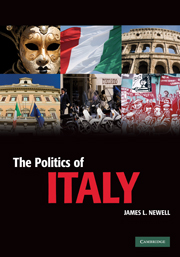Book contents
- Frontmatter
- Contents
- List of figures
- List of maps
- List of tables
- List of boxes
- Acknowledgements
- List of abbreviations
- Chronology
- Map 1 Italian regions and major cities
- Introduction
- I Historical background
- II The polity: structures and institutions of the regime
- III Politics: citizens, elites and interest mediation
- IV Policies and performances
- Appendix: The electoral system for the Chamber of Deputies and the Senate
- References
- Index
Introduction
Published online by Cambridge University Press: 05 August 2012
- Frontmatter
- Contents
- List of figures
- List of maps
- List of tables
- List of boxes
- Acknowledgements
- List of abbreviations
- Chronology
- Map 1 Italian regions and major cities
- Introduction
- I Historical background
- II The polity: structures and institutions of the regime
- III Politics: citizens, elites and interest mediation
- IV Policies and performances
- Appendix: The electoral system for the Chamber of Deputies and the Senate
- References
- Index
Summary
In 2006, Italy saw a general election which resulted in the incumbent centre-right government being ousted in favour of the alternative coalition of the centre left. It saw the defeat of wide-ranging proposals for constitutional reform in a popular referendum. It saw Italy win the FIFA world cup. All three of these things bore witness to the fact that Italy is a normal country.
If the normal pattern of party politics in European countries is left–right alternation in office sustained by bipolar competition, then the April general election showed that Italian party politics conformed to this pattern: the centre-right Casa delle Libertà (CdL) coalition of parties, under Silvio Berlusconi, had won the election held in 2001. For the 2006 election to the Chamber of Deputies, the centre-left Unione, under Romano Prodi, came from 3.8 per cent behind to stake out a position 0.3 per cent ahead of the CdL, in the process taking over the reins of government with a majority of sixty-six seats. If a ‘normal’ country is one in which constitutional arrangements provide political integration by offering fixed and enduring points of reference for the large majority of players, then it had to be of significance that in June voters decisively rejected wide-ranging proposals for change, in the process ruling out the likelihood, for the foreseeable future, of major alterations to the constitution that had been adopted in 1948.
- Type
- Chapter
- Information
- The Politics of ItalyGovernance in a Normal Country, pp. 1 - 6Publisher: Cambridge University PressPrint publication year: 2010

